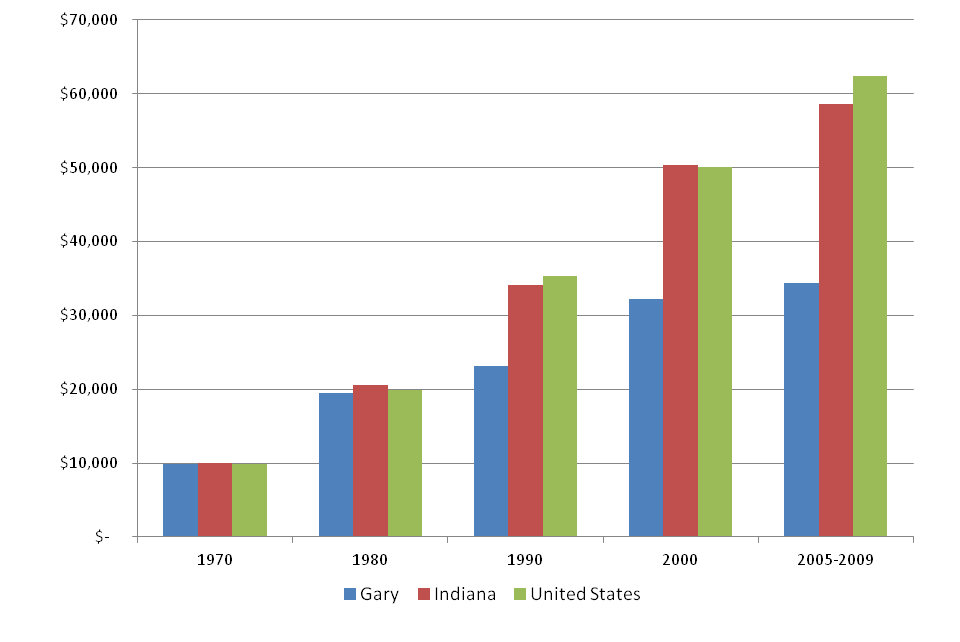Gary Profile
Background on Gary, Indiana
Gary is located 25 miles south of Chicago, Illinois. It borders Lake Michigan, the water source for the steel mills that once dominated the area. The city, named after U.S. Steel founder, Elbert Gary, has tracked the successes and failures of the steel industry over time. Before the 1960s, Gary was a prosperous city that relied heavily on the steel industry. Since then, like many cities that relied on one manufacturing industry, Gary has experienced a dramatic decline along with the city's main industry, steel.
Change in Manufacturing & Need for Workforce Development
As depicted below, Gary’s manufacturing employment fell from almost 50% in 1970 to 13.5% in 2005-09. With much of the steel industry moving overseas in the early 1970s, Gary’s employment in the sector went from about 30,000 people in the boom years to approximately 8,000 people today. With the dramatic loss of job, work force development should have been a high priority. However, with shrinking tax revenue and little assistance from the state of Indiana, the city’s leadership had to make difficult choices, and did not put a great emphasis on work force retraining. Gary also experienced a severe “brain drain” during this period as senior management and highly skilled workers moved out of the city to find work elsewhere. The exodus of educated workers led to the common expression: “Last one out of Gary, please turn out the lights.”
Table 1. Manufacturing employment
| 1970 | 1980 | 1990 | 2000 | 2005-2009 | |
|---|---|---|---|---|---|
| Manufacturing | 49.39% | 42.92% | 25.67% | 19.02% | 13.49% |
Population Change
As shown in the table below, the population of Gary has continuously declined since 1970. Significantly, Gary’s image became one of deteriorating housing, corruption, and crime. At one point, the city was known as the “murder capital of the world.” The soaring crime problem also contributed to the majority of the middle class leaving the city, causing additional private sector deterioration and further diminishing tax revenues and public resources.
Between 1970 and 2005-09, the percentage of Whites in Gary declined from 46.7% to 14.9%, while the Black population grew from 52.8% to 80.0%.
Table 2. Gary population
| 1970 | 1980 | 1990 | 2000 | 2005-2009 | |
|---|---|---|---|---|---|
| Total Population | 175,415 | 151,953 | 116,646 | 102,746 | 96,368 |
| White | 46.66% | 25.38% | 16.31% | 11.92% | 14.85% |
| Black | 52.84% | 70.77% | 80.57% | 84.03% | 80.04% |
Additionally, as you can see below, the median family income for Gary in the 1970’s was consistent with Indiana and the United States. However, since that time the median family income in Gary has lagged both the state and the United States.
Chart 1. Median family income

Looking to the Future
As the city has declined economically, so has all the relationship between government and private industry and opportunities for public/private partnerships, with a few notable exceptions. The local Majestic Star Casino provides a number of college scholarships. The utility NIPSCO (Northern Indiana Public Service Co.), U.S. Steel, and Methodist Hospital provide some grants, educational and youth mentoring services. The city is benefiting from the Northwest Indiana Regional Development Authority project to revitalize the lakefront (the entire Indiana Lake Michigan lakeshore) and commercial properties including the airport. Finally the newly-elected, reform-minded mayor, Karen Freeman-Wilson, aims to put Gary on the road to prosperity. While there is a new sense of hope, the city has many longstanding challenges.








